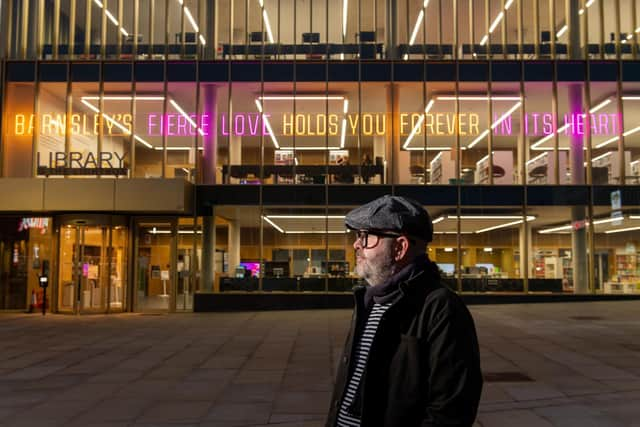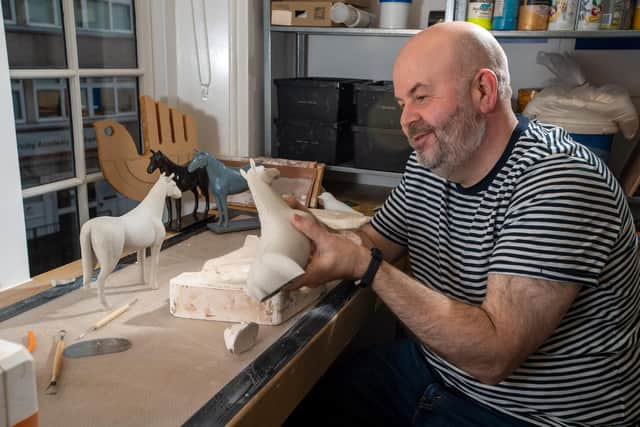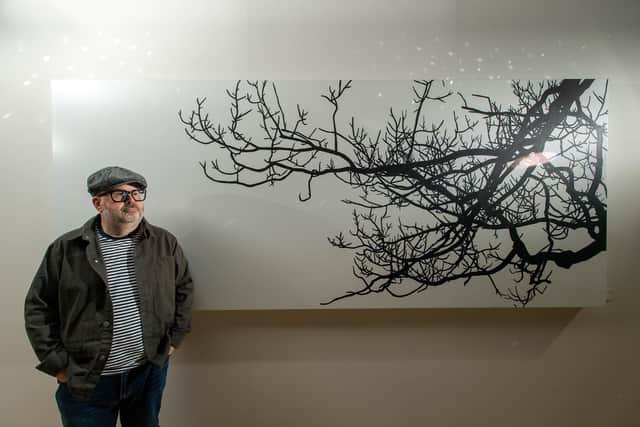How Barnsley artist Patrick Murphy's teachers encouraged his work
Maths wasn’t the forte of one little lad in the corner of the classroom at St Joseph’s School in Kendray, the Barnsley community that sits between Doncaster Road and Sheffield Road. The primary school is long gone, but it is still very fresh in the mind of Patrick Murphy.
“I was so completely bored,” he recalls with a broad grin. “I used to sit there, with my pencil and some paper, but instead of working out my sums, I’d be putting down something I saw around me, or what I observed through the window.”
Advertisement
Hide AdAdvertisement
Hide AdRecognising that he had talents beyond equations, Patrick’s teachers encouraged him to practise his drawing. He needed no second invitation. And what he showed them afterwards – a landscape inspired by the view from the school grounds – was so good it was framed and hung in one of the corridors.


It seemed inevitable that Patrick would end up at the nearby Barnsley School of Art. “The teaching was simply brilliant, in that it was across a multitude of disciplines – basic drawing, ceramics, design, you name it. And that’s good, because you learn a lot and it also helps a student to find their way, and to discover which field is special to them,” he says.
“I learned the other day that David Hockney was horrified that some colleges don’t even have basic drawing classes these days – and I share his horror.”
Today, Patrick is an artist, designer and curator. His work is exhibited internationally and held in public and private collections, and covers everything from large-scale art installations and interventions to print and sculptural work.
Advertisement
Hide AdAdvertisement
Hide Ad

He has a two-room studio behind the acclaimed Cooper Art Gallery in Barnsley. The Cooper is one of those cultural treasures that is relatively limited in space but is brilliantly innovative and it not only shares some of its site with Patrick, but also its international reputation – and the Cooper also offers a home to another renowned Yorkshire artist, the sculptor Graham Ibbeson, who has studio space straight across the landing from Patrick.
One of Patrick’s recent commissions comically echoes his work ethic. “I refuse to be pigeon-holed,” he says. Ironic, perhaps, given he was asked to sculpt those very birds for an installation at the Walker Art Gallery in Liverpool. “No pun intended,” he adds with a grin.
The multi-coloured results are witty and joyous. They perch everywhere – outside and inside the gallery. Patrick spent countless hours on Merseyside meticulously placing his static feathered creations. He wasn’t so lucky when asked to do much the same thing on the town hall of Le Havre, in France.
Liverpool wanted pigeons. Le Havre requested models of seagulls – hundreds of them, all over the building that replaced the previous bombed-out structure. Opened in 1958 and a classic example of fine modernist work, it is a focal point not only for the locals, but for tourists, and it is now home – for the foreseeable future – to Patrick’s white gulls. The title here was “To every bird, its own nest is beautiful”, and for Liverpool the theme was just a single word: “Belonging”.
Advertisement
Hide AdAdvertisement
Hide Ad

The Le Havre installation is unusual in two respects, firstly because a British artist was asked to create it – in the wake of Brexit – and secondly because between the invitation and the actual placing of the seagulls, both countries were in lockdown.
So, instead of travelling over to France to supervise the works, Patrick found himself collaborating with colleagues in Le Havre via Zoom. He still hasn’t managed to travel and see the finished work in person.
During lockdown he took regular walks from his home in nearby Darfield (which he shares with his wife Tracey) down to a nearby field. He took his sketchbook with him and drew the horses that he found there. The sketches are beautiful line drawings and these, in turn, became models – first cut (as were the pigeons and the gulls) with a 3D printer. Working on that equipment is another skill he has mastered. They are now an individual plaster model, deliciously tactile and about eight inches high, which will hopefully be cast in a bronze limited edition.
Patrick is able to work on both a small scale and a grand one. He proved that with another installation that was, instead of eight inches high, eight miles long – a vibrant laser of green light which shone down the Dearne Valley from Barnsley and could be seen in Doncaster.
Advertisement
Hide AdAdvertisement
Hide AdOther large-scale neon projects are currently occupying his attention. These too developed from lockdown, and, in a collaboration with Ian McMillan, became Words of Resilience. They were created simply to brighten up the day-to-day journeys of people in the town. The largest, at the Lightbox, combines Ian’s words and Patrick’s images and vibrantly spells out:
“Barnsley’s fierce love holds you forever in its heart”.
Among the many things that we can all look forward to is another neon sculpture destined for the area to the side of Barnsley’s Civic Theatre and a public art piece for Penistone. The latter will feature two 3 metre-high granite columns, topped by a pair of bronze sculptures. The first will depict the local breed of sheep and the other a sheaf of wheat. Patrick confesses that he never knows what will be coming around the corner to inspire him. It could be the old typefaces, Barnsley’s Eldon Street in Victorian times, or the first elegant flyovers of motorway Britain.
The constant themes are “Does it have integrity; does it challenge me?” The “common thread” to all his work, he recognises, always concerns “getting art into the public realm, off gallery walls and into our landscapes, to allow people to engage with it in public life”. That, of course, is a serious issue, to be applauded and encouraged. But to do it with a sense of humour, and the fact that it makes us all think, as well as smile, makes Patrick Murphy a truly individual artist and one that we should cherish.
We should be deeply grateful to that teacher, more than 40 years ago, who sent the lad who couldn’t get his sums right out into the open air to develop his remarkable talents. We may not have a mathematician in our midst, but we have an internationally respected and much-loved creative spirit.
patrickmurphystudio.co.uk
